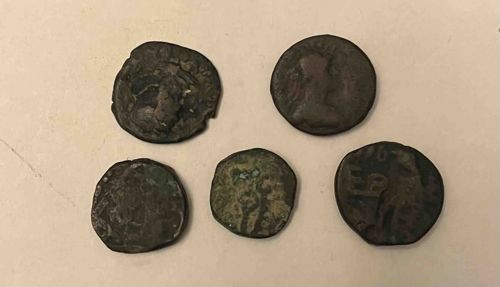
Collection of Five Ancient Bronze/Copper Coins
The image displays a collection of five ancient coins, appearing to be made of copper or bronze due to their characteristic dark brown to greenish-brown patina. Each coin is roughly circular, though none exhibit a perfectly round shape, suggesting hand-striking or significant wear over time. Their sizes appear to be relatively consistent, likely ranging from approximately 2 cm to 3 cm in diameter, though precise measurements are not possible from the image. The surfaces are heavily patinated, with varying degrees of encrustation and oxidation. Some coins show areas of light green oxidation, particularly visible on the bottom center coin, which points to a cupric composition. Details on the obverse and reverse sides are largely obscured by wear and patina, making definitive identification challenging without clearer images or direct examination. However, one coin (top left) clearly depicts a profile bust, likely a ruler or deity, characteristic of ancient coinage. Another coin (top right) also shows a profile bust, possibly of an emperor or empress, with some drapery visible. The bottom right coin appears to feature a standing figure or a complex scene, but the details are too worn to discern. The overall condition of all five coins is fair to poor, characterized by significant wear, edge losses, and surface corrosion. There are no discernible maker's marks, signatures, or specific manufacturing details visible due to the state of preservation. Based on the visible iconography and general appearance, these coins are consistent with ancient Roman or Greek provincial issues, possibly dating from the Roman Imperial period (1st to 4th centuries CE) or earlier Hellenistic periods. The irregular shapes and worn details are typical of many excavated ancient coins, particularly those made of base metals. The craftsmanship, though difficult to assess fully, appears to be consistent with ancient minting practices where uniformity was not always paramount. The heavy patina suggests prolonged exposure to burial conditions.
AI-Generated Appraisal Disclaimer
Estimated Value
$150-300
Basic Information
Category
Ancient numismatics
Appraised On
November 28, 2025
Estimated Value
$150-300
Item Description
The image displays a collection of five ancient coins, appearing to be made of copper or bronze due to their characteristic dark brown to greenish-brown patina. Each coin is roughly circular, though none exhibit a perfectly round shape, suggesting hand-striking or significant wear over time. Their sizes appear to be relatively consistent, likely ranging from approximately 2 cm to 3 cm in diameter, though precise measurements are not possible from the image. The surfaces are heavily patinated, with varying degrees of encrustation and oxidation. Some coins show areas of light green oxidation, particularly visible on the bottom center coin, which points to a cupric composition. Details on the obverse and reverse sides are largely obscured by wear and patina, making definitive identification challenging without clearer images or direct examination. However, one coin (top left) clearly depicts a profile bust, likely a ruler or deity, characteristic of ancient coinage. Another coin (top right) also shows a profile bust, possibly of an emperor or empress, with some drapery visible. The bottom right coin appears to feature a standing figure or a complex scene, but the details are too worn to discern. The overall condition of all five coins is fair to poor, characterized by significant wear, edge losses, and surface corrosion. There are no discernible maker's marks, signatures, or specific manufacturing details visible due to the state of preservation. Based on the visible iconography and general appearance, these coins are consistent with ancient Roman or Greek provincial issues, possibly dating from the Roman Imperial period (1st to 4th centuries CE) or earlier Hellenistic periods. The irregular shapes and worn details are typical of many excavated ancient coins, particularly those made of base metals. The craftsmanship, though difficult to assess fully, appears to be consistent with ancient minting practices where uniformity was not always paramount. The heavy patina suggests prolonged exposure to burial conditions.
Get Your Items Appraised
Instant estimates of your treasures with AI-powered instant appraisals